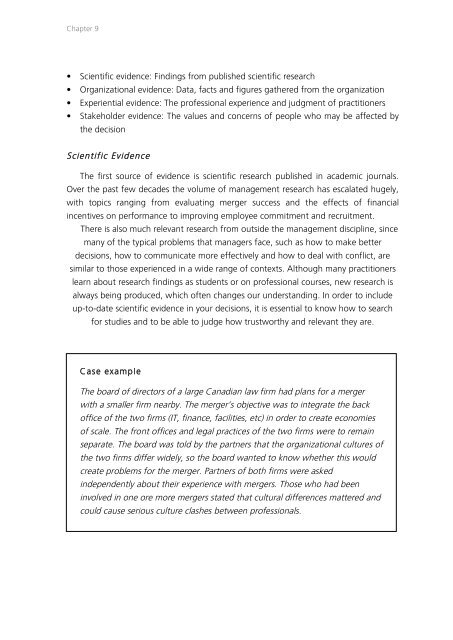In Search of Evidence
jqluvth
jqluvth
Create successful ePaper yourself
Turn your PDF publications into a flip-book with our unique Google optimized e-Paper software.
Chapter 9<br />
• Scientific evidence: Findings from published scientific research<br />
• Organizational evidence: Data, facts and figures gathered from the organization<br />
• Experiential evidence: The pr<strong>of</strong>essional experience and judgment <strong>of</strong> practitioners<br />
• Stakeholder evidence: The values and concerns <strong>of</strong> people who may be affected by<br />
the decision<br />
Scientific <strong>Evidence</strong><br />
The first source <strong>of</strong> evidence is scientific research published in academic journals.<br />
Over the past few decades the volume <strong>of</strong> management research has escalated hugely,<br />
with topics ranging from evaluating merger success and the effects <strong>of</strong> financial<br />
incentives on performance to improving employee commitment and recruitment.<br />
There is also much relevant research from outside the management discipline, since<br />
many <strong>of</strong> the typical problems that managers face, such as how to make better<br />
decisions, how to communicate more effectively and how to deal with conflict, are<br />
similar to those experienced in a wide range <strong>of</strong> contexts. Although many practitioners<br />
learn about research findings as students or on pr<strong>of</strong>essional courses, new research is<br />
always being produced, which <strong>of</strong>ten changes our understanding. <strong>In</strong> order to include<br />
up-to-date scientific evidence in your decisions, it is essential to know how to search<br />
for studies and to be able to judge how trustworthy and relevant they are.<br />
Case example<br />
The board <strong>of</strong> directors <strong>of</strong> a large Canadian law firm had plans for a merger<br />
with a smaller firm nearby. The merger’s objective was to integrate the back<br />
<strong>of</strong>fice <strong>of</strong> the two firms (IT, finance, facilities, etc) in order to create economies<br />
<strong>of</strong> scale. The front <strong>of</strong>fices and legal practices <strong>of</strong> the two firms were to remain<br />
separate. The board was told by the partners that the organizational cultures <strong>of</strong><br />
the two firms differ widely, so the board wanted to know whether this would<br />
create problems for the merger. Partners <strong>of</strong> both firms were asked<br />
independently about their experience with mergers. Those who had been<br />
involved in one ore more mergers stated that cultural differences mattered and<br />
could cause serious culture clashes between pr<strong>of</strong>essionals.


